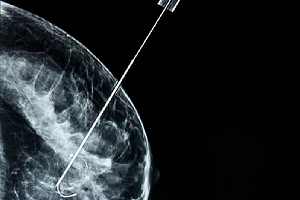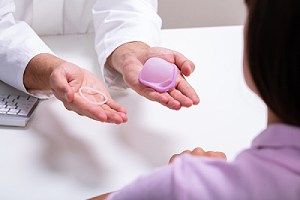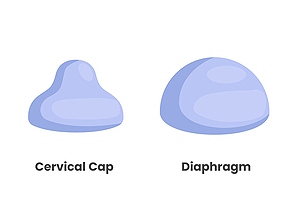Taking good care of your breasts involves keeping up with routine breast exams. By incorporating regular breast exams into your health regimen, you will be better able to recognize problems developing at an early stage and improve your chances of having a long and healthy life.
Breast Examinations and Their Benefits
 Regular breast examinations are the best way to detect changes in your breasts that could be signs of a serious health problem. As the years go by, your breasts will change. These changes are common. Many times, the changes are consistent with hormonal changes that occur with normal aging. The good news is that most of the changes you notice in your breasts are hormonal and not caused by cancer.
Regular breast examinations are the best way to detect changes in your breasts that could be signs of a serious health problem. As the years go by, your breasts will change. These changes are common. Many times, the changes are consistent with hormonal changes that occur with normal aging. The good news is that most of the changes you notice in your breasts are hormonal and not caused by cancer.
Regular examination will help you notice when something has changed in your breasts. Regular examinations enable you to detect any change at its earliest stage. Early detection allows your health care provider to diagnose the issue and develop appropriate testing and treatment protocols.
If the diagnosis is breast cancer, your doctor can treat it before it becomes life-threatening. In short, good breast care through regular examinations can be life-saving.
Routine Breast Examinations
There are several types of routine breast examinations. They include:
Self-Examination
 Many women who have had breast cancer reported that the first sign of their breast cancer was a new breast lump that they discovered during a self-examination. Self-examination is important because it helps you improve your breast awareness so that you understand what is normal and better able to detect changes in them.
Many women who have had breast cancer reported that the first sign of their breast cancer was a new breast lump that they discovered during a self-examination. Self-examination is important because it helps you improve your breast awareness so that you understand what is normal and better able to detect changes in them.
When performing a self-examination of your breasts, you should do a visual inspection for changes in how they look, and use your hands to determine any changes to the way they feel. Make sure to do your self-examination at a time when you are not having your period. Your hormone levels fluctuate during your menstrual cycle, which can cause your breasts to become tender and the tissues to swell. A good time to perform a self-exam is the week after the end of your period.
If you do notice anything new, you should discuss it with your doctor. Again, changes are common and most of them are not cancer. However, the changes could be an infection or skin condition that needs medical treatment. In particular, you should promptly see your doctor if you notice any of the following conditions:
- A hard lump in one or both of your breasts, even if it is very small
- Unusual or unexplainable pain, warmth, swelling, or tenderness.
- Fluid leaking or discharge from a nipple
- One of your nipples appears to be pulling inward instead of poking out
- The skin of one of your breasts is turning red, dimpling, or puckering
Screening Mammogram
 A mammogram is a special x-ray of your breasts. A mammogram can detect problems in your breasts and cancer before you can feel a cancerous lump. A screening mammogram can provide your doctor with a baseline of what is normal for your breasts. After that, the frequency of a screening mammogram depends on your age and health profile. Your doctor can advise you on how often you should have a screening mammogram for optimal breast care.
A mammogram is a special x-ray of your breasts. A mammogram can detect problems in your breasts and cancer before you can feel a cancerous lump. A screening mammogram can provide your doctor with a baseline of what is normal for your breasts. After that, the frequency of a screening mammogram depends on your age and health profile. Your doctor can advise you on how often you should have a screening mammogram for optimal breast care.
Special Examinations
If a mammogram has detected an abnormality in your breasts, your doctor will recommend that you get a more detailed examination. It is important for your health that you follow through with the additional testing to properly diagnose the abnormality. There are a number of tests that your doctor may order for you. These include.
Diagnostic Mammogram
During a diagnostic mammogram, the technologist will take several detailed images of the suspicious area as directed by the radiologist. The detailed images will help in the evaluation of your screening mammogram.
Breast Ultrasound
Frequently, an ultrasound will be performed along with a diagnostic mammogram to evaluate the suspicious area identified in your screening mammogram. It is a painless procedure that uses sound waves to make images of the inside of your breast. It is used to help determine if a lump in your breast is a benign cyst or a solid mass and to pinpoint the position of a tumor.
An ultrasound is also a good breast health test for women whose breast tissue is too dense for a mammogram, pregnant women, and women younger than 25 years old.
Biopsy
 A biopsy is an out-patient procedure where your doctor uses a small needle to take tissue from part of your breast. The tissue is evaluated under a microscope. A biopsy is the only way to know for sure if the tissue is cancerous.
A biopsy is an out-patient procedure where your doctor uses a small needle to take tissue from part of your breast. The tissue is evaluated under a microscope. A biopsy is the only way to know for sure if the tissue is cancerous.
Follow Up
Sometimes, the doctor will recommend follow up testing every three or six months to make sure there are no abnormal changes occurring in your breasts. By closely monitoring your breast health, your doctor will be able to quickly treat any problems that develop in between your regular mammograms. Early treatment is imperative to your overall health.
Contact the Breast Care Experts At Raleigh Gynecology and Wellness
Good breast care is an important aspect of good health care overall for women. Consult with the women’s health experts at Raleigh Gynecology and Wellness for more information about breast health and schedule an appointment.

 Experts believe that
Experts believe that  Avoid refined sugars and fats, which cause you to gain weight and subject you to a higher risk of breast cancer. Get in the habit of reading food labels when you are grocery shopping. Look for sugars and fats in the product and avoid consuming foods loaded with ingredients that are bad for your health.
Avoid refined sugars and fats, which cause you to gain weight and subject you to a higher risk of breast cancer. Get in the habit of reading food labels when you are grocery shopping. Look for sugars and fats in the product and avoid consuming foods loaded with ingredients that are bad for your health. Keep your vitamin D level up. Medical experts think that low levels of vitamin D can increase your risk of developing breast cancer. Also, breast cancer survivors with low vitamin D levels may have a greater risk of disease recurrence.
Keep your vitamin D level up. Medical experts think that low levels of vitamin D can increase your risk of developing breast cancer. Also, breast cancer survivors with low vitamin D levels may have a greater risk of disease recurrence. Barrier contraception methods prevent pregnancy by blocking the sperm from reaching an egg and fertilizing it. Barrier contraceptives consist of a range of devices and medically formulated substances. Each has its advantages and disadvantages, as described below.
Barrier contraception methods prevent pregnancy by blocking the sperm from reaching an egg and fertilizing it. Barrier contraceptives consist of a range of devices and medically formulated substances. Each has its advantages and disadvantages, as described below. The female condom is a thin membrane that is placed inside the vagina no more than eight hours before having sex. Use of the female condom is controlled by the female. With a female condom, a male condom cannot be used.
The female condom is a thin membrane that is placed inside the vagina no more than eight hours before having sex. Use of the female condom is controlled by the female. With a female condom, a male condom cannot be used. The cervical cap is similar to a diaphragm. It is a small rubber cap that covers the cervix to block sperm from entering the uterus. You must insert the cap before sex and leave it in place for up to eight hours afterward. Like the diaphragm, you can have sex more than one time with the cap left in place. However, you should remove it within 48 hours after having sex.
The cervical cap is similar to a diaphragm. It is a small rubber cap that covers the cervix to block sperm from entering the uterus. You must insert the cap before sex and leave it in place for up to eight hours afterward. Like the diaphragm, you can have sex more than one time with the cap left in place. However, you should remove it within 48 hours after having sex. If you are not ready to have children, you need to think about hormonal contraception. When appropriately used, hormonal contraceptives are incredibly effective. However, hormonal contraceptive methods each have their own pros and cons. Before you decide which contraceptive option you prefer, you may want to consider the pros and cons of different hormonal contraceptives.
If you are not ready to have children, you need to think about hormonal contraception. When appropriately used, hormonal contraceptives are incredibly effective. However, hormonal contraceptive methods each have their own pros and cons. Before you decide which contraceptive option you prefer, you may want to consider the pros and cons of different hormonal contraceptives. Certain hormonal contraceptives can help to alleviate unpleasant premenstrual symptoms. Some women struggle with symptoms like moodiness or physical complaints like cramping or bloating during the week before their period. This is referred to as premenstrual syndrome or premenstrual dysphoric disorder, which is an extreme form of premenstrual syndrome. The use of hormonal contraceptives may alleviate these uncomfortable symptoms.
Certain hormonal contraceptives can help to alleviate unpleasant premenstrual symptoms. Some women struggle with symptoms like moodiness or physical complaints like cramping or bloating during the week before their period. This is referred to as premenstrual syndrome or premenstrual dysphoric disorder, which is an extreme form of premenstrual syndrome. The use of hormonal contraceptives may alleviate these uncomfortable symptoms. Hormonal contraceptives are the most effective form of birth control, second only to abstention. Their effectiveness depends entirely on their proper use. For example, the Nexplanon hormonal implant is over 99% effective in preventing pregnancy for three years once it is implanted– the woman never has to do anything else. However, the birth control pill loses its effectiveness significantly if the woman forgets to take a pill for a single day.
Hormonal contraceptives are the most effective form of birth control, second only to abstention. Their effectiveness depends entirely on their proper use. For example, the Nexplanon hormonal implant is over 99% effective in preventing pregnancy for three years once it is implanted– the woman never has to do anything else. However, the birth control pill loses its effectiveness significantly if the woman forgets to take a pill for a single day. With the wide variety of
With the wide variety of  One of most effective contraceptives is the hormonal implant, called Nexplanon. It is a thin plastic rod that resembles a matchstick. It contains hormones and works by releasing a small amount of hormones into your body that prevents you from getting pregnant. Your healthcare provider uses a special instrument to insert the device under the skin of your upper arm. Once implanted, you do not have to do anything else to prevent pregnancy.
One of most effective contraceptives is the hormonal implant, called Nexplanon. It is a thin plastic rod that resembles a matchstick. It contains hormones and works by releasing a small amount of hormones into your body that prevents you from getting pregnant. Your healthcare provider uses a special instrument to insert the device under the skin of your upper arm. Once implanted, you do not have to do anything else to prevent pregnancy.  Condoms block the sperm from entering your vagina and reaching the egg. However, a condom can fail if it is damaged or if it is not properly fitted. One advantage to condoms is that they are the best way (other than abstinence) to prevent the transmission of a sexually transmitted disease.
Condoms block the sperm from entering your vagina and reaching the egg. However, a condom can fail if it is damaged or if it is not properly fitted. One advantage to condoms is that they are the best way (other than abstinence) to prevent the transmission of a sexually transmitted disease.